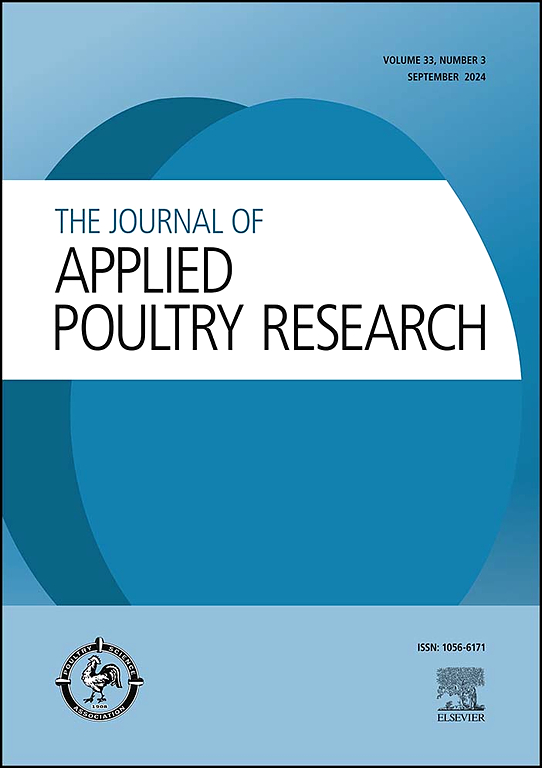Laboratory assays do not consistently indicate under processing of soybean meal that negatively impacts broiler performance
IF 2
3区 农林科学
Q2 AGRICULTURE, DAIRY & ANIMAL SCIENCE
引用次数: 0
Abstract
Poultry are primarily fed corn- and soybean-based diets in the United States. Soybean meal (SBM) has a high crude protein content and an excellent amino acid profile; however, it contains several antinutritional factors that have been shown to hinder bird performance. Soybean crush plants utilize a toasting step to degrade these heat-labile antinutrients in meal, but many factors vary across crush plants that can make it difficult to determine processing adequacy. Furthermore, current analytics may not properly indicate optimal processing. Therefore, two experiments were conducted. The objectives of the first experiment were to characterize under-processed, peak-processed i.e. optimally processed, and over-processed solvent-extracted SBM from a commercial crush plant with trypsin inhibitor activity (TIA) using the new USDA-ARS method, TIA with the AOCS method, urease, solubility in potassium hydroxide (KOH) and protein dispersibility index (PDI) in addition to evaluating assay variation within and across commercial laboratories. The objective of the second experiment was to determine the effect of the three aforementioned SBM types on broiler performance when included in mash diets and fed for 21 days. Three diets were formulated to 85 % crude protein and digestible amino acid requirements, differing only in the processing type of SBM. A nutritionally adequate positive control (PC) diet was also formulated. Diets were fed in mash form. Analysis of the SBM samples indicated an increase in trypsin inhibitor (TI) from under to peak-processed, then a decrease from peak to over-processed. Urease, KOH, and PDI analysis revealed variation within and among laboratories, with the most consistent measure of processing adequacy being urease. Urease decreased with increasing processing according to 2 of the 3 laboratories. Live weight gain (LWG) increased by 52 g for birds fed the peak-processed diet relative to the under-processed diet (P < 0.05). Feed conversion ratio increased when birds were fed the under-processed diet relative to all other diets (P < 0.05). Broiler chick live performance demonstrated nutritional differences in soybean meal samples that were not consistently identified through various ingredient assays. Bird performance results aligned best with the urease assay.
实验室分析并没有一致地表明豆粕加工对肉鸡生产性能有负面影响
在美国,家禽主要以玉米和大豆为主。豆粕具有较高的粗蛋白质含量和优良的氨基酸结构;然而,它含有几种抗营养因子,已被证明会阻碍鸟类的表现。大豆压榨植物利用烘烤步骤来降解这些热不稳定的抗营养物质,但许多因素在压榨植物之间存在差异,这使得难以确定加工的充分性。此外,当前的分析可能无法正确指示最佳处理。因此,我们进行了两个实验。第一个实验的目的是利用新的USDA-ARS方法、AOCS方法的TIA、尿素酶、氢氧化钾(KOH)溶解度和蛋白质分散指数(PDI),以及评估商业实验室内部和不同实验室之间的测定差异,对商业压榨厂中具有胰蛋白酶抑制剂活性(TIA)的SBM进行未加工、峰值加工(即最佳加工)和过度加工的表征。第二个试验的目的是确定上述三种SBM类型在混合饲粮中添加21 d后对肉鸡生产性能的影响。3种饲粮的粗蛋白质和可消化氨基酸需取量均达到85%,不同的只是加工方式不同。同时还配制了营养充足的阳性对照(PC)日粮。饲粮以糊状饲喂。SBM样品的分析表明,胰蛋白酶抑制剂(TI)从低到峰处理增加,然后从峰到过度处理减少。脲酶、KOH和PDI分析揭示了实验室内部和实验室之间的差异,脲酶是最一致的加工充分性指标。根据3个实验室中的2个,脲酶随着处理的增加而下降。饲喂高加工日粮的禽类的活重增加(LWG)比饲喂低加工日粮的禽类增加52 g (P <;0.05)。相对于其他饲粮,未加工饲粮提高了饲料转化率(P <;0.05)。肉鸡的活产性能表现出豆粕样品的营养差异,但通过各种成分分析不能一致地确定。禽鸟生产性能结果与脲酶试验结果最吻合。
本文章由计算机程序翻译,如有差异,请以英文原文为准。
求助全文
约1分钟内获得全文
求助全文
来源期刊

Journal of Applied Poultry Research
农林科学-奶制品与动物科学
CiteScore
4.10
自引率
10.50%
发文量
80
审稿时长
104 days
期刊介绍:
The Journal of Applied Poultry Research (JAPR) publishes original research reports, field reports, and reviews on breeding, hatching, health and disease, layer management, meat bird processing and products, meat bird management, microbiology, food safety, nutrition, environment, sanitation, welfare, and economics. As of January 2020, JAPR will become an Open Access journal with no subscription charges, meaning authors who publish here can make their research immediately, permanently, and freely accessible worldwide while retaining copyright to their work. Papers submitted for publication after October 1, 2019 will be published as Open Access papers.
The readers of JAPR are in education, extension, industry, and government, including research, teaching, administration, veterinary medicine, management, production, quality assurance, product development, and technical services. Nutritionists, breeder flock supervisors, production managers, microbiologists, laboratory personnel, food safety and sanitation managers, poultry processing managers, feed manufacturers, and egg producers use JAPR to keep up with current applied poultry research.
 求助内容:
求助内容: 应助结果提醒方式:
应助结果提醒方式:


